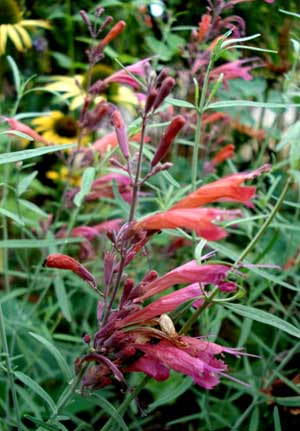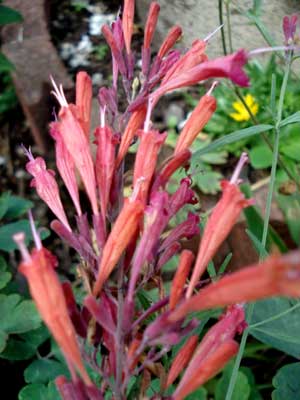
Licorice Mint
aka, Sunset Hyssop
or, Rock Anise
or, Threadleaf Hyssop
or, Rootbeer Plant
"The fragrant herbs of the woods & the
modest flowers of the fields give sweeter &
more graceful perfume after the rustic has
trodden them under foot."
-Juan Valera
(1824-1905)
With so very many hybridized agastache cultivars in the marketplace, it's sometimes forgotten that species plants are often just as nice & in some cases hardiest, as is the case with Licorice Mint (Agastache rupestris), native of the American southwest's cool high mountains of Arizona & New Mexico.(1824-1905)
 Because in the hot Southwest it actually prefers cool elevations, it's highly adaptable to sea level gardens in the Pacific Northwest, where it is highly floriferous & longlived.
Because in the hot Southwest it actually prefers cool elevations, it's highly adaptable to sea level gardens in the Pacific Northwest, where it is highly floriferous & longlived.There are a number of amazingly beautiful hybrid agastache cultivars with gorgeous flowers, but which, here in the northwest, are very apt to rot out in damp winters, or else they tire themselves to death with persistent flowers & haven't enough energy to last the winter, becoming defacto annuals. A couple examples out of many include 'Apricot Sunrise' & ' Pink Panther.' But A. rupestris as a pure species hyssop has flowers as persistent & as beautiful as the cultivars, while much closer to a guaranteed survivor year upon year.
A Plant Select Winner for 1997, Licorice Mint is typically labeled "Sunset Hyssop" in reference to the multi-hued flowers reminiscent of western sunsets. A few select seed-strains are sold with trademark names not really cultivars, such as "Apache Sunset" or "Desert Sunrise," which may or may not exhibit distinct color impressions.
Licorice Mint is also known as Rock Anise because of the poor rocky soil in which it can do well. It's also known as Threadleaf Hyssop for the leaves that are so slender & distinct from the likes of the wrinkle-leafed hyssop A. rugosa. And it is also known Licorice Hummingbird Mint for obvious reasons; or even Rootbeer Plant.
It's occasionally misnomered the threadleaf "Giant Hyssop" though there's nothing giant about it; that's just the literal meaning of the genus name. Not a dense clump, it's a loosely leafed plant, growing to about two feet, rigidly upright. Long established clumps grow to three feet including the spikes of blooms. The leaves are very thin & airy, silvery grey-green, & do not crowd plants around it.
These leaves are redolent of sassafrass or rootbeer, one of the best-smelling foliages imaginable, & useful as a garnish for ice tea, or a few finely chopped leaves sprinkled into fruit dishes, or mixed with garden-fresh oregano & for soups or fried foods including morning eggs.
It's cold-hardy ‚ potentially to Zone 6, though ideal for zones 7 & 8. It can be endangered by too much winter wetness, so may require a ledge location that dries swiftly to make it through Northwest winters reliably. If there's really no way to keep it sufficiently winter-dry to perennialize, or if grown below Zone 6, it will still be a great plant if regarded as an annual.
So this hummingbird favorite wants full sun in sharply draining soil, with a little watering through particular dry days of summer. The orange-coral-and-pink petalled, & lavender-calyxed flower spikes, last from mid-summer to mid-autumn, or longer, asking only for one late-summer deadheading to insure excellent autumn rebloom.
It is said to be deer resistant, but fat chance at that. It does attract bees & butterflies in addition to hummingbirds. Second-year clumps become increasingly drought-hardy. If shaded or too often watered its leaves can be afflicted with mildew. If that happens, clip & discard rather than compost the whole plant, & move the roots to a sunnier spot that is not right in the watering zone.
Seeds may be collected after they've dried on the plant, to be started in coldframes. It'll sometimes self-seed right in the garden, or can be winter-sewn into the garden in order to appear in spring in permanent locations. But given the wet winters on Puget Sound it's more successful to protect Licorice Mint through the seedling stage.
In all, it's a terrific plant for hardiness, beauty, & that extraordinary scent. Put it near the garden edge where you can rub the leaves as much as you'll inevitably want to do, & carry a bruised sprig in a shirt pocket or in your hair so that you'll smell like the tastiest rootbeer ever brewed.